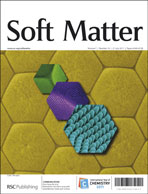Fabrication and mechanical properties of microchambers made of polyelectrolyte multilayers†
Abstract
A highly ordered array of hollow chambers ranging from 2 to 25 μm in size are fabricated using the layer-by-layer assembly of poly(allylamine hydrochloride) and poly(sodium 4-styrenesulfonate) on sacrificial templates with imprinted patterns of wells. Polyelectrolyte multilayer (


 Please wait while we load your content...
Please wait while we load your content...